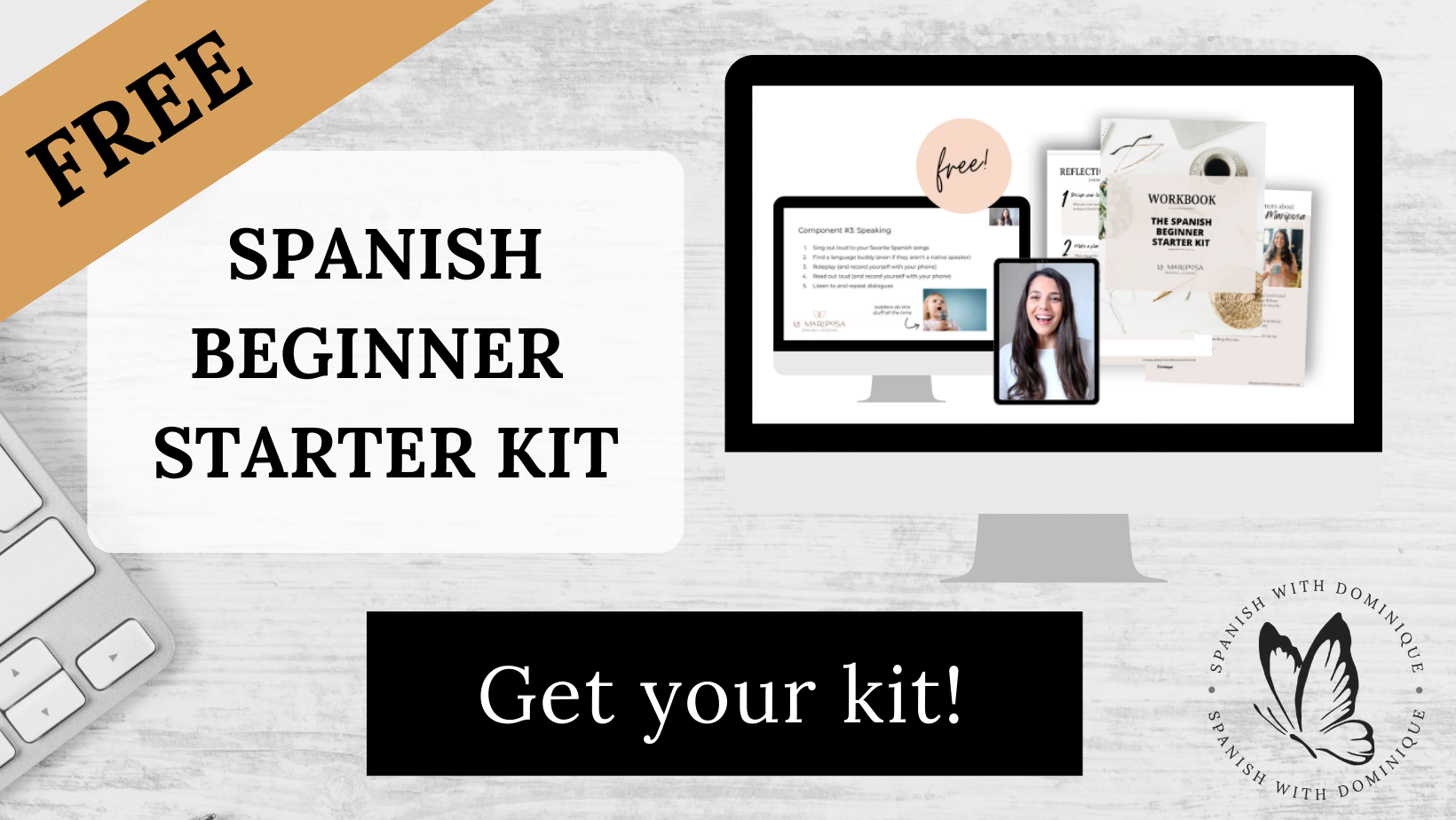4 Strategies to Help You Make Time to Learn Spanish as an Adult
In this post: Four strategies to help the busiest people make time in their schedules and stay committed to learning Spanish as an adult.
Do you really have time to learn Spanish as an adult?
If you’re like most of us these days, it probably feels like you don’t.
You’ve got work to manage, kids, the dog. Maybe you’ve got an agenda so full that you’re afraid to even take a peek and see if there’s time for a workout or coffee with a friend.
Could you really fit a Spanish session in there? If you’re like most of the smart (and busy!) people I’ve worked with, you’ve probably asked yourself this question before. But what if it’s the wrong question?
What if finding time for Spanish is not about magically creating extra hours in the day?What if finding time for Spanish is more about figuring out what really matters — to you? And committing to it?
What if you found ways to make sure that making that commitment was not scary and time-consuming but something completely doable?
And what if you learned the smartest possible ways to commit to actually learning Spanish as an adult in the most efficient way? Because you’re busy. And you deserve to use all the best strategies out there.
Ready to change the way you think about finding time for learning Spanish? Then let’s jump in!
While reading this post, think about these questions:
When is the last time you stopped to think about what really matters to you?
When is the last time you took a look at your schedule and added something to it that was not just a ‘to-do,’ but that was deeply important to you?
What if you thought about learning Spanish as a tiny, doable habit…instead of a giant goal to tackle all at once?
#1 Make time for what matters in your life
All of us have things we’re committed to. Like being a good parent or a good spouse or maintaining our personal health. When you are committed to something, you show up every day, even when things get complicated.
On Thursday morning, when your alarm goes off at 5 AM, and you just want to lay in bed. But you still get up and put on your gym clothes because you committed to working out on weekdays.
When you have an argument with your husband, and you really don’t want to “deal with it” you still approach him to work through it. Because you are committed to having a long and happy relationship, and so that means you’re invested in working through problems.
Think about it. If you’re in a relationship (a real, committed one) with your spouse or partner, do you ever stop to wonder… “Hmm…do I really have time for this?” Probably not if you want your relationship to thrive.
There’s something that’s easy to forget when you’re busy: When something really matters to you, you make time for it.
So…Is it important to you to connect with the Spanish-speaking people in your life?
To have those conversations?
To finally feel confident traveling in a Spanish-speaking country?
To open yourself up to a new world and a new way of thinking?
To be, well, a new person — in Spanish?
Because I’m here to tell you that if you really want to be that successful adult Spanish learner, you do have what it takes — even if you’re busy.
In fact, there’s something I’ve learned that might surprise you. Some of the busiest people I’ve worked with have also been the most successful at learning Spanish as adults.
I’ve worked with all types of people - from ambitious 24-year-olds to busy pregnant mothers to ER doctors - all of whom have learned Spanish as adults.
So what do they have in common?
They have a lot going on in their lives — just like the rest of us.
But they know what matters to them. And they find ways of putting that first. And for them, they committed to Spanish.
Don’t worry. Making a commitment to Spanish does NOT mean deciding not to eat, sleep, exercise, or spend time with your loved ones. We’re putting our priorities first, remember?
#2 Make your commitment to Spanish possible and doable
You’ve probably seen the research that tells you that Spanish is a language that takes about 600 hours to master.
And when you look at it that way, well, no wonder it sounds scary.But let’s take a step back and break those 600 hours into a doable task by choosing a reasonable amount of time to practice. Let’s start with 30 minutes a day.
And if you’re worried that you can’t sustain 30 minutes a day for an entire year…or that you'll get thrown off during the holidays? I have a trick.
I call it The Monarch Method to learning Spanish and I take hundreds of students through it every year in my ALAS Basic Spanish Course Series. So how does it work?
Well, think for a minute about the Monarch butterfly migration. They make an absolutely incredible journey as they do 4-6 week generational sprints from the US and Canada down to Mexico. But…they don’t spend their entire lives sprinting. In fact, they sprint…and then they rest.
This is how I teach my students to learn Spanish - bursts of 4-6 weeks of focused learning throughout the year with short breaks in between.
Most of the people I’ve helped through my programs are very relieved to learn that you can choose a few strategic moments to study a bit more intensely and see real progress.
You know, the kind of progress where you start to notice the transformation as Spanish gets easier for you. Where you don’t feel like a caterpillar anymore and start to spread your wings.
But you don’t have to sprint all the time.
Between sprints and times of rapid growth, you can progress at a more calm pace and just enjoy listening to your favorite music or podcasts for a few weeks.
That is how you’ll reach that 600-hour goal - one sprint at a time. That’s how you’ll make it feel doable instead of overwhelming.
#3 Forget trying to stay motivated to study Spanish and try this instead
When you have to rely on sheer willpower, it’s hard.
And the longer you try to rely on willpower and sheer motivation, the more impossible your job becomes. Just telling yourself you’re going to study Spanish for 30 minutes a day is doomed to failure if you don’t have a plan to keep things fun and easy.
It’s counterintuitive, isn’t it? But you need to stop doing things the hard way if you want to keep up your Spanish learning journey long enough to really see progress.
Make something easy to do, and it tends to get done! It’s also more fun, guilt-free, and a lot kinder to yourself.
To be successful at learning Spanish, one of the best ways you can make learning easy for yourself is by setting up habits. Habits that are so easy and simple to put into place that you just can’t fail.
What does that look like? Well, if you were on a diet and wanted to lose 10 pounds, you might:
Plan to park 10 minutes from your work and walk the rest of the way every day.
Bring a bottle of water with you and drink the whole thing each day.
Pack your lunch, so you don’t have to rely on fast food.
You might even make sure your home is stocked with healthy foods — so that eating good things is the easy default, not a question of walking past the donuts 15 times without eating one.
With Spanish, it may look something like...
Make sure you have easy-to-use and level-appropriate materials ready for you.
Decide where you want to study Spanish and make sure you’re materials are there ahead of time.
If you’re listening to a podcast, make sure it’s downloaded to your phone before you go for a run or to the gym.
If you want to review flashcards on your lunch break, pack them into your bag when you leave for work.
Be open to doing 10 minutes of practice in one sitting... and then reviewing the same material 10 minutes at another time during the day.
Don’t beat yourself up if you don’t have 30 minutes a day at first. Starting with whatever you have and working up from there!
Celebrate every small win!
More Posts Handpicked Just For You!
Enjoyed this post? Here are some more you might like.






Discover 7 must-read books for intermediate Spanish learners to boost fluency, overcome the plateau, and immerse yourself in engaging Spanish stories.